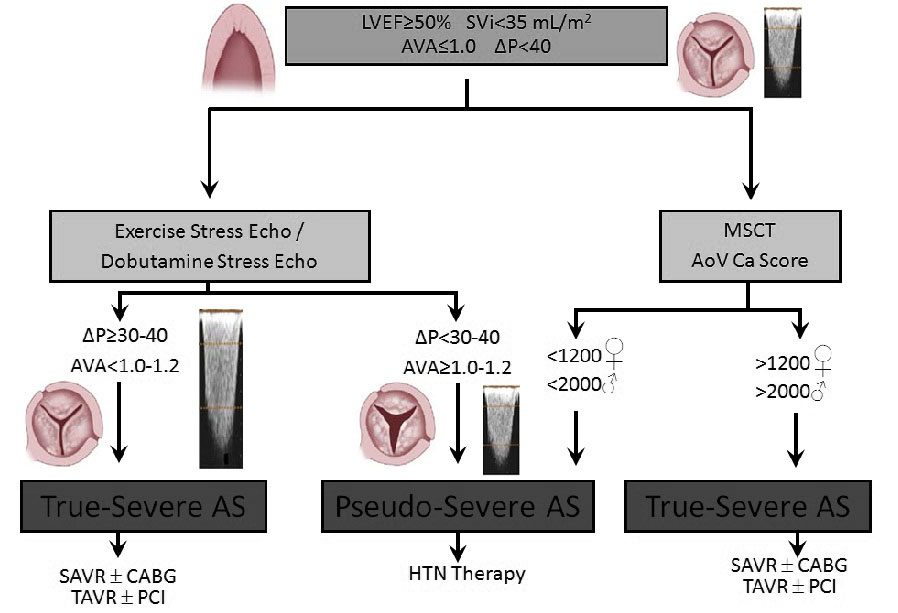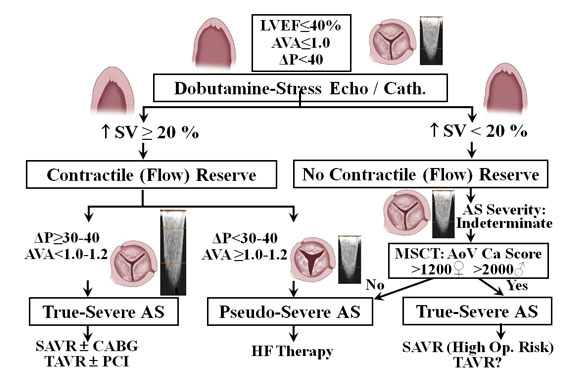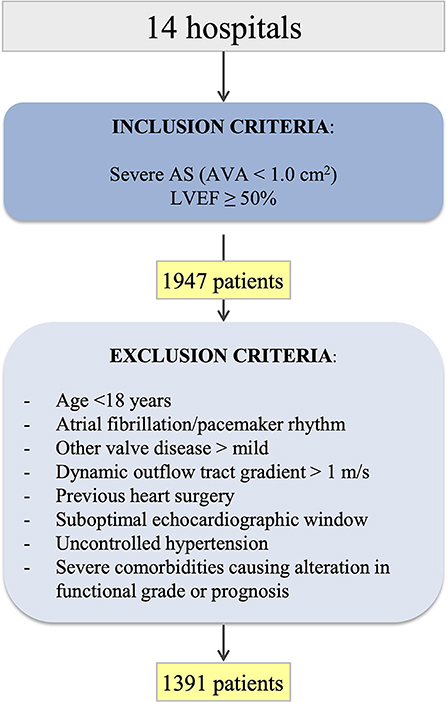low flow low gradient aortic stenosis guidelines
12 Moderate AS is defined as an AVA of 10 to 15 cm 2 a mean gradient of 25 to 40 mm Hg and a peak velocity of 30 to 40. Low-flow low-gradient aortic stenosis is a difficult entity to diagnose and treat.

Dobutamine Stress Echocardiography In Low Flow Low Gradient Aortic Stenosis Flow Reserve Does Not Matter Anymore Journal Of The American Heart Association
High gradient severe AS The 2020 American Heart AssociationAmerican College of Cardiology valvular heart disease guidelines identify severe aortic stenosis AS by the presence of an aortic transvalvular velocity 4 ms andor mean transvalvular pressure gradient 40 mmHg.

. Cleveland Clinic the 1 Heart Program in the United States for 27 Straight Years. Various diagnostic modalities are needed to accurately determine the severity of aortic stenosis and potential treatment benefit. Low-flow low-gradient severe aortic stenosis.
Management of Paradoxical Low-Flow Low-Gradient Aortic Stenosis Need for an Integrated Approach Including Assessment of Symptoms Hypertension and Stenosis Severity. Low flow is defined in the guidelines as a stroke volume index transvalvular pressure gradient is highly flow-dependent ie. Accurate assessment of AS severity is necessary for clinical decision-making.
This entity is defined as an LVEF 50 the presence of a low flow stroke volume index. The majority of patients with lflgas have decreased left ventricular systolic function ie lvef 50 have paradoxically low flow defined as a stroke volume index of. The aortic valve area AVA is typically 1 cm 2 with AVA indexed to body surface area 06 cm 2 m 2.
Low gradient low flow aortic stenosis is defined by a left ventricular ejection fraction 40 mean gradient 30 mm Hg and effective orifice area 10 cm 2. Low-flow low-gradient severe aortic stenosis AS is characterised by a small aortic valve area AVA and low mean gradient MG secondary to a low cardiac output and may occur in patients with either a preserved or reduced left ventricular ejection fraction LVEF. Paradoxical low-flow low-gradient aortic stenosis.
The first step in patients with symptomatic PLF AS should be to rule out measurement errors and treat hypertension. Echocardiography is currently the diagnostic method of choice for assessing and managing AS. Severe AS is defined as peak transvalvular flow velocity 4 ms mean gradient 40 mmHg andor AVA.
A European multicenter study. LF LG AS is characterized by combination of severe aortic valve stenosis calculated aortic valve area AVA low flow stroke volume 35 mlm 2. Transthoracic echocardiography is.
The second step is to d. Low gradient low flow aortic stenosis. 815 and guidelines 2 recommend classifying patients with small AVA and preserved LVEF into 4 groups according to their levels offlow ie SVi.
In the American College of CardiologyAmerican Heart Association guidelines the criteria for severe aortic stenosis are an effective orifice area less than10 cm or less than 06 cmm a transvalvular mean gradient greater than 40. True-severe classical and paradoxical low-flow low-gradient aortic stenosis can be distinguished from pseudo-severe aortic stenosis by dobutamine stress. Intervention is recommended for symptomatic patients with severe high-gradient aortic stenosis or with severe low-flow low-gradient aortic stenosis with LVEF 50 and evidence of flow reserve as well as for asymptomatic patients with severe stenosis who have systolic LV dysfunction LVEF 50 without another cause or who have symptoms on.
So the Low Flow Low gradient severe Ao Stenosis is existing. Low-flow low-gradient aortic stenosis is a difficult entity to diagnose and treat. Low-gradient AS LGAS is present in a significant proportion of patients with AS and is commonly due to low forward flow states.
In cases of low-flow low-gradient AS flow can be temporarily increased to assess the true. Both the American and European cardiac societies define severe AS as that associated with an aortic valve area AVA of 40 mm Hg and a peak transvalvular flow velocity of 40 ms. Various diagnostic modalities are needed to accurately determine the severity of aortic stenosis and potential treatment benefit.
Indeed discordant echocardiographic results are seen in one-quarter of patients most often arising from a valve area gradient stenosis 31 32. In this case the mean Gradient is 40 mm Hg so is clear it is a severe aortic stenosis. 21 these patients have lower peak transaortic velocities 35 versus 40 ms and lower mean gradients 32 versus 40 mm hg compared with patients who have normal.
In the american heart associationamerican college of cardiology and european society of cardiologyeuropean association of cardiothoracic surgery guidelines 1 2 severe aortic stenosis as is defined as a peak aortic jet velocity 40 ms a mean gradient 40 mm hg or an aortic valve area ava. Association of Cardiothoracic Surgery guidelines12severe aortic stenosis AS is defined as a peak aortic jet velocity 40 ms a mean gradient 40 mm Hg or an aortic valve area AVA. On the other hand the AVA may be.
2 However up to 50 of patients with severe AS are known to have low-gradient AS which is defined as AVA. Paradoxical LF-LG AS occurs in 5-15 of patients with AS2 and it is defined as a preserved LVEF 50 a low LV outflow ie. About 60 of patients with paradoxical low-flow low-gradient PLF-LG aortic stenosis AS have a severe disease that justifies aortic valve replacement AVR.
A low left ventricular ejection fraction with high peak transaortic velocity is an appropriate response to high afterload and does not imply a poor left ventricle. But dont forget the PEDOFF. True-severe classical and paradoxical low-flow low-gradient aortic stenosis can be distinguished from pseudo-severe aortic stenosis by dobutamine stress.
Aortic stenosis AS is the most common cardiac valve lesion in the adult population with an incidence increasing as the population ages. ACCAHA 2006 guidelines for the management of patients with valvular heart disease. Nevertheless AS might be overestimated because of an incomplete valve opening.
Its a complicated entity and the treatment is still debated even if some patients would probably take advantage of the aortic valve replacement. Aortic valve replacement for low-flowlow-gradient aortic stenosis operative risk stratification and long-term outcome. With this hemodynamic presentation it is difficult to distinguish true aortic valve stenosis where the primary culprit is severe aortic valve disease.
This Paradoxal LFLG AoS entity is defined by an AVA 10 cm 2 andor 06cm 2 m 2 when indexed for body. This article reviews the potential problems in evaluating aortic stenosis severity in low-flow low-gradient aortic stenosis the utility of dobutamine challenge to identify patients most. Jo urn al Pre- pro of The diagnosis of severe aortic stenosis AS is challenging when a small aortic valve area AVA is associated with low gradients not consistent with severe AS.
Ad Access a Free Guide on Aortic Valve Disorders Treatment From Cleveland Clinic. A squared function of flow and may thus be pseudo-normalized and underestimate stenosis severity in presence of low flow. Low-flow low-gradient aortic stenosis however is an especially challenging subset as valve replacement has a significant risk and may fail to alleviate symptoms or improve left ventricular function.
Stroke volume index low gradient. Aortic stenosis AS is defined as a peak aortic jet velocity 40 ms a mean gradient 40 mm Hg or an aortic valve area AVA.

Evaluation And Management Of The Patient With Low Flow Low Gradient Download Scientific Diagram

Case Of Classical Low Flow Low Gradient As With Pseudo Severe Stenosis Download Scientific Diagram

Pdf Low Flow Low Gradient Severe Aortic Stenosis Diagnosis And Treatment Semantic Scholar

Low Flow Low Gradient Aortic Stenosis When Is It Severe American College Of Cardiology

Pdf Assessment Of Low Flow Low Gradient Aortic Stenosis Multimodality Imaging Is The Key To Success Semantic Scholar

Paradoxical Low Flow Low Gradient Severe Aortic Stenosis A Distinct Disease Entity Heart

Outcome Of Flow Gradient Patterns Of Aortic Stenosis After Aortic Valve Replacement Circulation Cardiovascular Interventions

Complex Scenarios Paradoxical Low Gradient As In Normal Patients

Simplifying The Approach To Classical Low Flow Low Gradient Severe Aortic Stenosis A Renewed Emphasis On The Resting Transthoracic Echocardiogram International Journal Of Cardiology

Low Flow Low Gradient Aortic Stenosis When Is It Severe American College Of Cardiology

Prognosis Of Severe Low Flow Low Gradient Aortic Stenosis By Stroke Volume Index And Transvalvular Flow Rate Jacc Cardiovascular Imaging

Low Flow Low Gradient Aortic Stenosis When Is It Severe American College Of Cardiology

Complex Scenarios Low Gradient In Low Ef As Patients

A Flow Chart Of The Study Protocol Lgas Low Gradient Aortic Stenosis Download Scientific Diagram

Evaluation And Management Of The Patient With Low Flow Low Gradient Download Scientific Diagram

Frontiers Prognosis Of Paradoxical Low Flow Low Gradient Aortic Stenosis A Severe Non Critical Form With Surgical Treatment Benefits Cardiovascular Medicine

Distinction Of Classical And Paradoxical Low Flow Low Gradient Download Scientific Diagram

Paradoxical Low Flow Low Gradient Aortic Stenosis Circulation

Confirmation Of Aortic Stenosis Severity In Case Of Discordance Between Aortic Valve Area And Gradient Sciencedirect